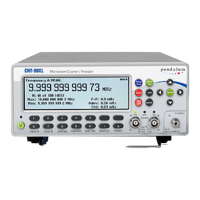case. The best case is when the displayed
value is 10000000. Then the quantization res-
olution corresponds to 0.5 LSD units.
± 1 unit in 99999999 (=1E8) means 10
times more relative resolution than ± 1
unit in 10000000 (=1E7), despite the
same number of digits.
A gradual increase of the measurement time
reduces the instability in the LSD caused by the
quantization uncertainty. At a specific
measurement time setting, the counter is justi-
fied to display one more digit. That one addi-
tional digit suddenly gives ten times more dis-
play resolution, but not a ten times less
quantization uncertainty. Consequently, a
measurement time that gives just one more
display digit shows more visual uncertainty in
the last digit.
For a stable LSD readout, the maximum mea-
surement time selected should be one that still
gives the required number of digits. Such opti-
mization of the measurement time enables the
total resolution to be equal to the quantization
resolution.
Measurement Time and Rates
The set measurement time decides the length of
a measurement if Frequency or Period Average
is selected.
This is important to know when you want to
make fast measurements, for example when
you are using the statistics features, or when
you are collecting data over the GPIB bus.
The so-called "dead time", that is the time
between the stop of one measurement and
the start of the next one in the course of a
block measurement, can be below 2 µs.
A block is a collection of consecutive mea-
surements, the results of which are stored in
local memory for statistics or plotting pur-
poses (STAT/PLOT menu) or for later trans-
fer to a controller over one of the data com-
munication links (GPIB, USB or
ETHERNET).
Additional controls over start and stop of
measurements
Free-running measurements may be easy to
understand, but measurements can get more
complex.
Besides input signal triggering, the start of a
measurement is further controlled by the fol-
lowing elements:
— Manual RESTART, if HOLD is selected.
— GPIB triggering (<GET> or *TRG), if bus
triggering is selected.
—
External arming signal, if Start Arming is
selected.
—
Expired start arming delay, if Arming
Delay is selected.
In addition to expired measurement time and
stop signal triggering, the stop of measurement
is further controlled by:
— External arming signal triggering, if Stop
Arming is selected.
GPIB triggering is described in the Program-
mer's Handbook.
Now let's look deeper into the concept of
arming.
What is Arming?
Arming is a pretrigger condition ("qualifier")
that must be fulfilled before the counter allows
a measurement to start.
5-5
USER MANUAL ● CNT 9x Series ● Rev.22 February 2020

